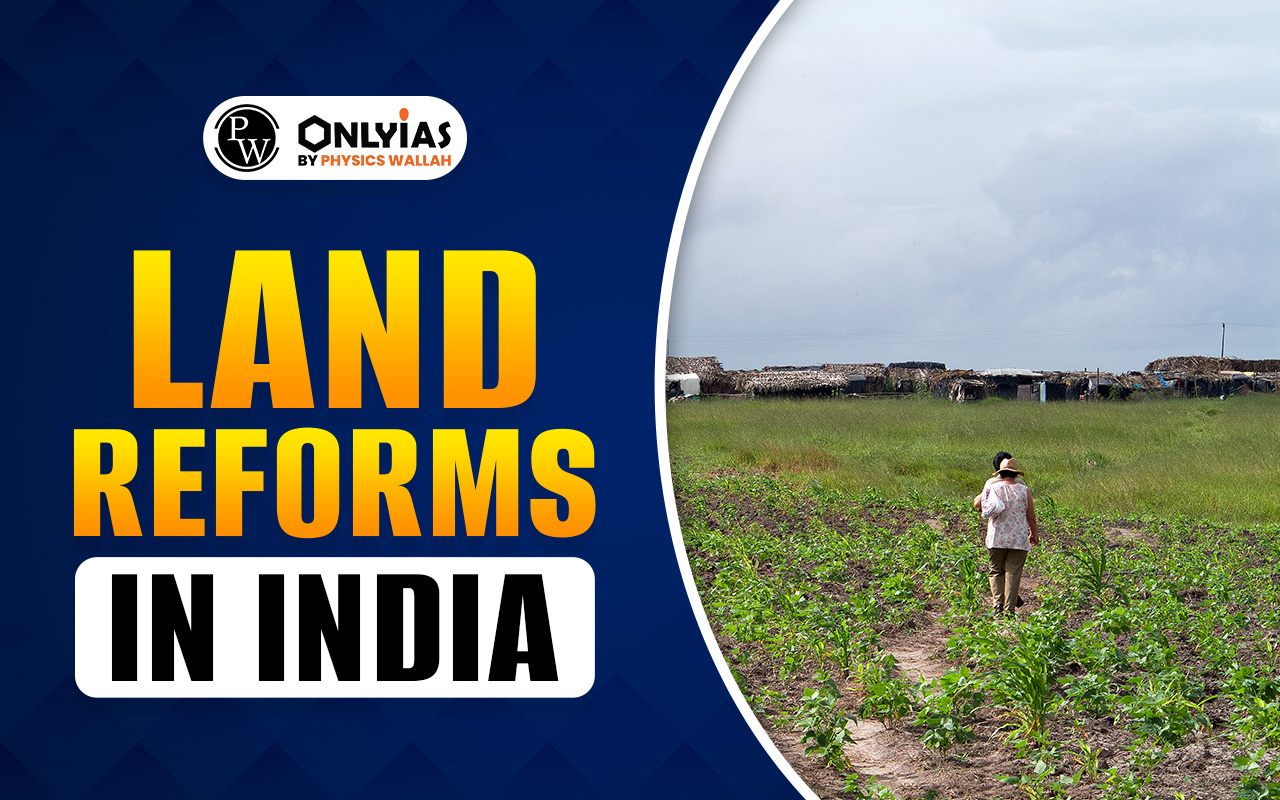Explore Land Reforms in India, from British-era Zamindari, Ryotwari, and Mahalwari systems to post-independence reforms like Zamindari Abolition, tenancy laws, land ceilings, and Bhoodan movement. Learn their impact on farmers, rural growth, and relevance for UPSC.

Land Reforms in India: Land has always been very important in India’s economy and daily life. But for a long time, land was not shared equally. People owned a lot of land, while many others had none. This caused poverty, unfair treatment, and insecurity for farmers. That’s why land reform became an important part of India’s plans and rules.
Land reforms in India tried to make land ownership more fair. They wanted to protect farmers’ rights and improve farming. These reforms included removing middlemen who took advantage of farmers, controlling tenancy (when farmers worked on someone else’s land), putting limits on how much land one person could own, and giving extra land to poor farmers. The main goal was to reduce inequality and bring fairness in society. Even today, in 2025, land reforms still matter because they help villages grow, reduce poverty, and make farming more productive.
For UPSC preparation, Land Reforms in India UPSC is a recurring theme. It overlaps with Indian history, economy, polity, and social issues. Questions appear in both prelims and mains.
Enroll now for UPSC Online Course
Land reforms in India were not the result of a single leader or government, but a gradual process shaped by committees, legislations, and social movements after independence.
Under British rule, cultivators were deprived of ownership. Systems like Zamindari, Jagirdari, and Ryotwari created layers of intermediaries who collected revenue but contributed little to cultivation. This led to exploitation of peasants and high rents.
The idea of land reforms formally entered India’s policy framework after independence.
British policies created lasting inequalities in land ownership. The three major land revenue systems introduced were:
| Land Reforms in India During British Rule | ||||
| System | Introduced By | Area of Operation | Key Features | Impact on Farmers |
| Zamindari System | Lord Cornwallis (1793, Bengal) | Bengal, Bihar, Orissa, UP | Zamindars as intermediaries; farmers became tenants | Farmers lost ownership, faced eviction, fell into debt |
| Ryotwari System | Thomas Munro (early 19th c.) | Madras, Bombay, Assam | Farmers (ryots) paid revenue directly to the state | Ownership granted but tax rates very high, causing indebtedness |
| Mahalwari System | Holt Mackenzie (1822) & Robert Merttins Bird (1833) | Punjab, Awadh, NW Provinces | Revenue assessed on entire villages (mahals) | Community responsibility, but poverty persisted |
The Zamindari system was introduced in Bengal in 1793 under Lord Cornwallis. Under this system zamindars acted as the middlemen. They used to collect revenue from farmers and then paid it to the government.
In this system, zamindars acted as intermediaries. They collected revenue from farmers and paid it to the government. Farmers lost ownership rights and became tenants. This led to exploitation, poverty, and insecurity for peasants.
Enroll now for UPSC Online Course
The Ryotwari land revenue system was started in parts of Madras and Bombay by Thomas Munro. In this system, the cultivator or ryot paid tax directly to the government. Farmers had ownership rights, but the tax rate was often high. Many peasants faced debt and hardship despite having some security.
The Mahalwari land revenue system was introduced in Punjab, Awadh, and other regions. Here, the revenue was collected from a group or village (mahal). The community was responsible for paying tax. Though it gave a sense of collective responsibility, the burden was still heavy. Farmers remained poor under this system.
After 1947, the main aim changed to bringing fairness and improving farming. New rules were made so that land could be shared more fairly and farmers working on the land could feel secure about their rights.
| Land Reforms in India After Independence | |||
| Reform / Movement | Objective | Impact / Achievements | Limitations |
| Zamindari Abolition Act 1956 | End intermediaries and transfer land to cultivators. | Over 20 million tenants benefitted; ownership rights to farmers. | Uneven implementation, compensation disputes, landlords exploited loopholes. |
| Tenancy Reforms | Regulate landlord–tenant relations; ensure fair rents and security. | Rent control, tenure security, ownership rights in some states. | Many tenants unrecorded; required strong political will. |
| Bhoodan & Gramdan Movements (1951) | Voluntary land donation (Bhoodan) and collective cultivation (Gramdan). | Raised awareness of land inequality; promoted moral reform. | Donated land often barren; weak enforcement. |
| Ceiling on Land Holdings in India | Prevent land concentration by setting maximum holding limits. | Some redistribution to landless farmers. | Loopholes like benami transfers reduced effectiveness. |
The Zamindari Abolition Act of 1956 marked a turning point. It ended the role of intermediaries like zamindars. Land was transferred to tenants, and many farmers gained ownership rights. Though effective in some regions, the act faced issues like legal disputes and compensation delays.
Enroll now for UPSC Online Course
Tenancy reforms aimed at giving security to tenants. The laws regulated rent, ensured fair conditions, and granted ownership rights in some cases. These reforms helped farmers invest more in land, as they felt secure. However, in many places, tenants were not properly recorded, which reduced the impact.
Acharya Vinoba Bhave led the Bhoodan and Gramdan movements in the 1950s. Rich landlords were asked to donate the land to the landless. Later, the entire villages were encouraged to share the land under Gramdan. These movements showed the role of voluntary action in social reform. While noble in vision, their practical results were limited.
To stop a few people from owning too much land, the government made a rule called the land ceiling. This rule said that no one could own land beyond a fixed limit. Any extra land was taken and given to people who had no land. The idea was good, but because of weak implementation and loopholes, it did not work as well as planned.
Enroll now for UPSC Online Course
Land reforms after independence were not only about giving land to people. They were also connected to India’s bigger goal of improving farming. Farmers got fair rights and secure land, it became easier to bring new technology and better methods. This helped increase crop production. One of the biggest changes that came from this was the Green Revolution.
| UPSC Mains Question: How did land reforms in some parts of the country help to improve the socio-economic conditions of marginal and small farmers? (150 words, 10 Marks) |
The Green Revolution introduced new technology, seeds, and irrigation in the 1960s. Land reforms had already set the stage by improving the ownership patterns. Farmers with secure land rights could adopt new practices. However, the regional differences meant the benefits were not equal. Some areas advanced rapidly, but others lagged behind.
| Green Revolution | ||||
| Aspect | Details | Purpose / Goal | Impact / Outcome | Limitations / Challenges |
| High-Yielding Variety (HYV) Seeds | New wheat and rice seeds producing more grain per acre | Increase crop productivity | Higher yield of wheat and rice; contributed to self-sufficiency by 1970s | Benefits concentrated in irrigated regions; small farmers could not afford seeds |
| Chemical Fertilizers and Pesticides | Fertilizers improved soil fertility; pesticides protected crops | Enhance soil productivity and reduce crop losses | Higher production and better-quality crops | Overuse led to soil degradation and environmental pollution |
| Irrigation Expansion | Tube wells, canals, and pump sets ensured regular water supply | Ensure reliable water for crops | Enabled multiple cropping and improved yield | Groundwater depletion in intensive farming areas |
| Mechanization | Tractors, harvesters, and threshers introduced | Reduce labor dependency and increase efficiency | Faster cultivation and harvesting; reduced manual effort | Small and marginal farmers could not afford machines |
| Government Support | Minimum Support Prices (MSP), subsidies, institutional credit | Encourage adoption of new technology | Farmers invested in inputs and irrigation; agricultural growth accelerated | Regional disparity; richer farmers benefited more |
Ready to boost your UPSC 2026 preparation? Join PW’s UPSC online courses today!
Early rulers tried, but structured reforms were introduced under British rule and later expanded after independence.
The major systems were the Zamindari system, Ryotwari land revenue system, and Mahalwari land revenue system.
It ended intermediaries and gave ownership rights to many farmers.
They promoted voluntary land donation and collective sharing, though results were limited.
They are crucial to understand agrarian history, economic development, and governance.
<div class="new-fform">
</div>
